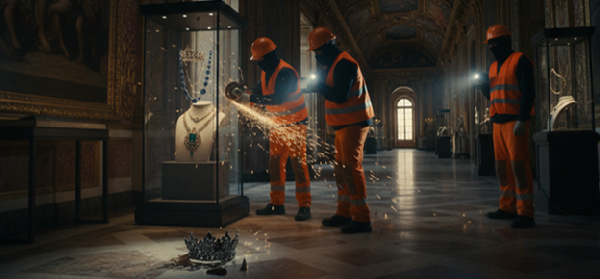
The Louvre Heist: When Neglect Becomes the Greatest Vulnerability
On October 19, 2025, the Louvre Museum once again made global headlines, not for a new exhibition, but for one of the most audacious and symbolic robberies of the 21st century.
In broad daylight, a group of criminals disguised as construction workers used a lift truck and power tools —saws and grinders —to access the museum’s second floor, directly into the legendary Galerie d’Apollon, where the museum kept some of France’s Crown Jewels.
Within minutes (authorities estimate they entered at 9:30 a.m.), the intruders stole nine pieces from two display cases: a tiara, a necklace, and an earring from the sapphire set of Maria Amalia of Naples and Sicily; an emerald necklace and earrings belonging to Maria Luisa of Austria; as well as a reliquary brooch, a large floral brooch, and the tiara of Empress Eugénie de Montijo. During their escape, the thieves dropped the empress’s crown, damaging it, a detail that only underscores the speed and precision with which they acted. At 9:37 a.m., the alarm was triggered. By 9:38, the thieves were already gone. Sixty seconds were enough to expose a structural vulnerability and a systemic failure in the world’s most visited museum.
As a security consultant, I cannot help but see this event not merely as a well-executed crime, but as the predictable outcome of a chain of ignored warnings. France’s national audit office (Cour des Comptes) had repeatedly cautioned about «persistent delays» in modernizing the Louvre’s security systems. Those in charge knew that a third of the rooms in the Denon Wing — where the theft occurred — lacked video surveillance, while in the Richelieu Wing, cameras covered barely a quarter of the space. Alarm and sensor systems, according to audit reports, were outdated or being updated at an unacceptably slow pace. In other words, the world’s most emblematic museum was operating under a protection scheme belonging to the last century.
To this technological weakness must be added an even more decisive factor: the human element. Cuts to security and maintenance staff, along with excessive workloads, had been publicly denounced months before the theft. Some galleries even closed temporarily due to a lack of guards. When the alarm went off, the response channel was as fragile as the technical system that supported it. The breach, therefore, was not merely technical — it was organizational. And the precision of the operation suggests insider knowledge of vulnerabilities, perhaps with some degree of internal cooperation or privileged information.
This incident was not the first of its kind. In 1976, three thieves stole from the very same area — the Galerie d’Apollon — taking the jewel-encrusted sword of King Charles X, also through a window. Fifty years later, unknown individuals repeated the same method. When incidents recur in the same pattern, the problem is not security — it is institutional memory.
Beyond the historical value of the jewels, this case carries a profound lesson for anyone managing security, operations, or corporate governance: security is not an expense — it is a strategic investment in continuity, reputation, and resilience. When budgets treat it as a «variable for adjustment,» risks quietly accumulate until they boil over into a crisis. No camera, alarm, or guard will suffice if leadership fails to understand that protecting assets — cultural, human, or corporate — requires vision, commitment, and persistence.
Lessons Learned
The «heist of the century» at the Louvre reminds us that effective security rests on three inseparable pillars:
- Updated technology — to anticipate, deter, and detect threats in real time.
- Competent and trustworthy personnel — trained to act with judgment, not just follow protocols.
- Conscious leadership — which understands that security is not delegated; it is directed and prioritized.
Technology without training is ineffective. Personnel without strategic backing are vulnerable. And leadership without a vision for risk is blind.
Organizations that fail to learn from their breaches inevitably repeat them.
The Louvre robbery, executed in just 60 seconds, exposed not only a technical flaw but also a cultural one — because, in security, the enemy is not always outside. Sometimes, it hides within the complacency of those who believe that «it could never happen here.»
